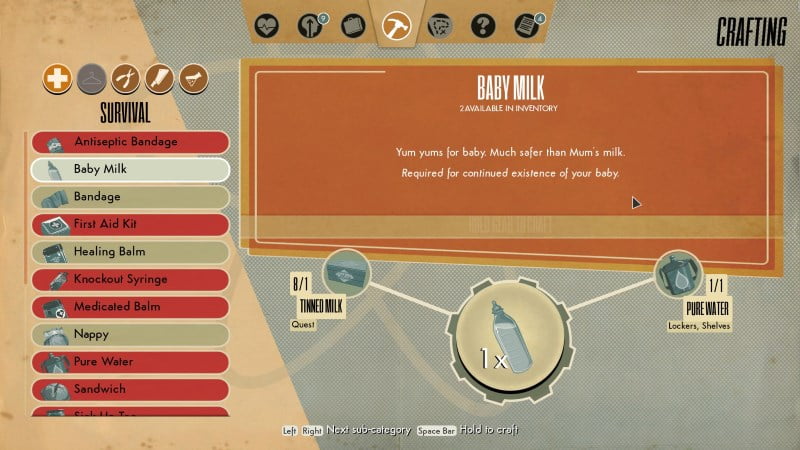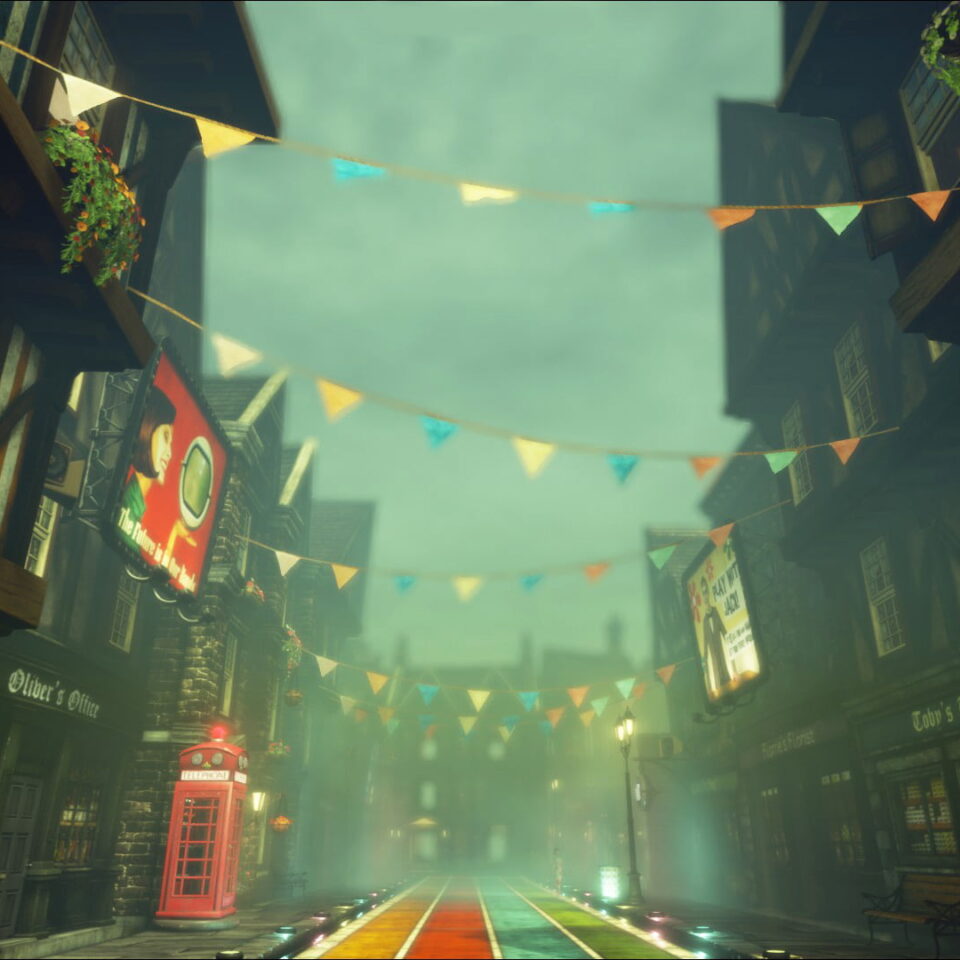The opening of We Happy Few is intriguing.
It’s the one we’ve all seen already, with the news redaction machine, the disgusting pinata, and waking up with a bump on your head in a maintenance closet. It sets up the game’s key themes – of repressed memories, paper masks, papered cracks, and a groovy alternate 1960s Britain – and reels you in. Hard.
Arthur, the game’s first protagonist, finds himself in the garden district, a neglected area of Wellington Wells populated by wastrels who are off their Joy, a mandatory, extreme, mood-altering medication. His first task is to take a rock and wreck his beautiful suit, so that he doesn’t stick out as a resident of one of the “better” districts. He needs to find his way back into the nicer parts of town so that he can uncover his past, some of the dark secrets of the world he inhabits, and ultimately, get the hell out of Dodge.
What that means, in reality, is survival mechanics, fetch quests, and lots and lots of backtracking.
You’ve probably seen the amazing visuals and slick style of the upscale districts of We Happy Few – replete with cheery residents, copious bunting, and a literal rainbow road – but if you can’t stomach a couple of hours of tedious crafting and schlepping, you might well give up before you ever get to see it. When you get there, having begged, borrowed, and bludgeoned your way across the bridge, it’s like stumbling into the Emerald City of Oz for the first time. It’s intoxicating.


Then everyone realises you’re in a tattered suit, off your meds, and in need of a thorough kicking.
Old ladies peer at you with suspicion in their eyes. Passers-by wonder if you should see a doctor. Then the automated security systems blare out that you are most definitely off your Joy, and traditional British bobbies pop out of pneumatic tubes and proceed to beat the tar out of you. You have three options at this stage: fight back; run and hide; or take your medicine. That’s literally consuming medication, as opposed to figuratively accepting your beating, though you may end up doing both.
With combat clumsy and stealth suspect, the easiest thing to do is to stumble into a repurposed red British phone box, open the hatch, and throw down a Joy pill. When you do, the world is changed. Birds sing, butterflies flutter before your eyes, and everything is tinged with a dewy glow. It’s actually quite nice. It also makes moving around town much easier, far more so than the game’s stealth systems. It’s hard to imagine what the downsides are to taking your Joy.


But there are downsides. Between debilitating withdrawal and overdose effects, not to mention the narrative overtures of memory loss, We Happy Few is keen to drive home the idea that using medication to overcome unhappiness is a major societal issue, one that they’re keen to skewer and lampoon. In an interview with Pop Ramen News, which is no longer an active website but is still available via the Wayback Machine, Compulsion Games’ narrative director Alex Epstein says of the narrative: “We Happy Few is inspired by, among other things, prescription drug culture – the idea that no one should have to be sad if they can pop a pill and fix it.”
It’s a concerning inference, the idea that everyone in We Happy Few is engaging in mere escapism, and that anyone (in the game, or the real world) who chooses to use medication to deal with issues of anxiety or unhappiness is refusing to face reality. It doesn’t help that the use of Joy in We Happy Few is so euphoric – closer to LSD than any real world medication – and so easily conflates recreational drug use with important prescription medications, like antidepressants.
Beyond these unsettling undercurrents, the world of We Happy Few is less black and white than Compulsion’s awkward authorial intent suggests. The residents of Wellington Wells are taking Joy to forget a horrific thing they all did during the Second World War. In some specific cases they have additional, personal burdens they want to forget (or in Arthur’s case, fight to remember). That’s entirely understandable, but through a bizarre system of self-policing and peer pressure, this has grown into something akin to an Orwellian nightmare. The authority figures in place – from the manufacturers of Joy to the doctors and bobbies who police its use – are covering up both imperfections in Joy and its widespread use, and the crumbling foundations of the town itself.
For a game whose themes seem so outwardly clumsy, We Happy Few is a surprisingly well-written and beautifully-performed – and very unique – sketch of an alternate history. Outside of The Man in the High Castle, itself based on a story published by Philip K. Dick in 1962, these flavours of dystopia are rarely explored in modern media. For the dozens of The Walking Dead or The Last of Us-style settings out there, it’s a genuine thrill to find games like Everybody’s Gone to the Rapture, The Occupation, and yes, We Happy Few.


Unfortunately, further mechanical and pacing issues – including the dreaded “come back in x days” timed missions – turn what should be an intriguing narrative into a painful, repetitive slog. Because We Happy Few is procedurally generated with core narrative quests applied over the top (and is perhaps meant to be played permadeath, though you can vary the levels of difficulty and punishment to suit) it lacks the finesse of a manually built world. If you get a bad roll, it can add hours onto your playthrough in frustrating fetch questing.
Then there’s the length of the story itself. When I reached the end of Arthur’s adventure, I was done in. We Happy Few had outstayed its welcome by a good few hours, but if it had been a tightly-focused three-to-five hour story, I would have come away happy. As it stood, I had grown to resent a game I had started off quite enjoying. Then a loading screen helpfully informed me I was beginning act two. There are three acts in total, all taking on the core story from the point of view of three different characters. What a downer.
Nominally, it brings to mind System Shock 2, of that choice at the beginning, between Agent, Navy, or Marine. Arthur is fast and lean, built for stealth and evasion. Sally is clever, a chemical whiz, who uses potent potions to her advantage (but also is a mother, which is a huge disadvantage in terms of more survival gauges to monitor; more scathing social commentary, guys?). Ollie is a big bloke and he hits stuff, hard. In RPG terms, it’s rogue, mage, and warrior, but for the most part, you’ll still find yourself having to fight your way out, run away, or take your Joy.


In System Shock 2, however, nobody forces you to replay the game again – albeit with different quests and perspectives on the main story beats – as the other two classes to unlock the full narrative. It’s either arrogance on the part of We Happy Few’s developers that all three characters are so brilliant and distinctly different that it’s worth making you play them all (they’re not; it isn’t), or it’s the artificial elongation of a game in service of the reductive length-equals-value sentiment. Perhaps its somewhere in between.
Either way, We Happy Few is an intriguing narrative in an evocative setting, wrapped up in some clumsy systems and clunky procedural generation, that is ultimately just too long and burdened by busywork. And then, when you realise it’s too long and you’re no longer enjoying it, you’ve still got several hours of Arthur’s story to play. And then it asks you to play through it twice more.
Game: We Happy Few
Platform: Windows (reviewed), PlayStation 4, Xbox One
Developer: Compulsion Games
Publisher: Gearbox Software
Release Date: Out Now






